I love pastrami. It has a nice smoke/salt balance that just makes the best sandwiches. So, it was a must to make my own. Welcome to PWE Pastrami.
Why PWE? We have an acreage in the Canadian Rockies and we call it Passing Wind Estates.
So, settle in, get a beverage and relax. This is going to be a long post. It’s not that making pastrami is hard, it just takes a few steps.
I will start with some basics of curing meat. Pastrami is a cured meat product. You have to use curing salts to make pastrami. Curing salts are a mixture of salt and sodium nitrite.
The curing salts inhibit bacterial growth during the long smoking process. If you cold smoke meat for hours without curing, it will go bad.
The curing salts also give pastrami its distinctive colour and taste.
Curing salts go by many names, Instacure #1, Prague Powder #1, Pink Salt and many more. Just make sure it is 6.25% sodium nitrite and the rest is salt.
The problem is that too little curing salt will not protect the meat and too much can make you sick. It is imperative you use the right amount.
There are two ways of introducing curing salts. One is a dry rub and the other is a brine where they are mixed with water. Pastrami is made with a brine.
When you are using a brine, you need to add the appropriate amount of cure for the total weight of the water in the brine and the meat. You are trying to get the right ratio of cure to the weight of both. As your brining container may be a different size than mine, if you adjust the cure to the total weight of both the water and the meat, you will have the appropriate ratio of cure.
I would like to strongly recommend you get a small scale to measure the curing salts by weight. It is just more accurate and you will get a better result.
Pastrami is traditionally made from brisket. I have made it from inside round, blade roast and other cuts. They are OK but the texture just isn’t as good. I recommend you get a whole brisket (sometimes referred to as a whole packer).
When you get the brisket, you will note there is a large strip of fat through it. This strip separates two pieces of the brisket, the point and the flat. The point is at the thick end of the brisket. The flat is leaner and the point is fattier.
If you went to an old time deli like when I was growing up and asked for a pastrami sandwich, they would ask you if you wanted lean or fatty. They would cut from the flat for lean and the point for fatty.
Some people, me for one, prefer the lean flat for pastrami. So, I carefully cut through the fat line and separated the point from the flat. I used the flat to make my pastrami and made burnt ends out of the point (my next post).
If you want some fatty pastrami, feel free to leave the point on.
Trim any large knots of hard fat and the thick fat cap to between 1/4 and 1/3 inch thickness.
I like to make some 1/4 inch deep slices at ninety degrees to the grain. Sometimes, the surface of the brisket gets so crusted, it is hard to keep track of the grain. These slices make it easy to cut across the grain when you are done.
Weigh the piece of meat you will be using and record it. You will need it later to determine the amount of rub.
Now you will be making the brine. You must have a non-reactive container to brine your pastrami in. That means food grade plastic, glass, ceramic or stainless steel. No iron, aluminium or steel can be used.
Put your container on the scale and zero it. Put the meat in the container and cover it with water. Write down the weight of the meat and water.
If your scale doesn’t have a tare function that lets you zero the weight of the scale with the container on it, weigh the container. Weigh the container, meat and water. Subtract the weight of the container from the total weight to get the weight of the meat and water.
Take the meat out of the water and put it on a tray.
For every kilogram of meat and water, add the following to the water:
- 30 ml kosher salt
- 3 grams Prague powder #1
- 25 ml sugar
- 1 bay leaf
- 1 ½ ml garlic powder
- 1 ½ ml juniper berries
- 1 ½ ml black peppercorns
My water and meat weighed a total of 5 kilograms. So I added 15 grams (3 times 5) of Prague powder #1. Do this calculation for each ingredient.
If you work in pounds, add the following amount for each pound of water and meat:
- 2 3/4 teaspoon kosher salt
- 0.048 ounces Prague powder #1
- 2 1/4 teaspoon sugar
- 1/2 bay leaf
- 1/8 teaspoon garlic powder
- 1/8 teaspoon juniper berries
- 1/8 teaspoon black peppercorns
I mixed the ingredients together to dissolve. Then I used a syringe injector to inject brine in every inch to two inches on both sides of the brisket.
Put the brisket in the brine. Put a plate on top to keep it submerged. Put the container in the fridge.
Let it marinate for four days, turning occasionally.
Take the brisket out of the brine and inject the brisket with the brine again. Put the brisket back in the brine and marinate for 5 more days, turning occasionally.
Take the meat out of the brine and rinse it off under running water.
Measure the following ingredients for a rub. For each kilogram of meat only:
- 20 ml peppercorns
- 20 ml juniper berries
- 12 ml whole coriander
If you use pounds, measure the following amounts per pound of meat only:
- 2 teaspoons peppercorns
- 2 teaspoons juniper berries
- 1 teaspoon whole coriander
Run these through a spice grinder but just give it a quick pulse. You are not trying to grind the spices, you are just trying to break a few of the seeds.
Mix the ingredients together and rub them into all surfaces of the brisket.
Wrap the brisket in plastic wrap and let it sit in the fridge for two days.
Remove the plastic wrap and put the brisket on a rack over a roasting pan. Either let it sit on the counter for 2 hours and pat it dry every 15 minutes with paper towel or put it in an oven at 140 to 150 F for an hour. This is to dry the surface which allows the smoke to give a better flavour.
I preheated my Louisiana Grills pellet smoker to 230 F with apple pellets. I like apple with pastrami but it goes well with oak or even hickory. Put the pan with the brisket on it in your smoker.
Smoke the brisket to an internal temperature of 150 F. This took about 4 hours but will vary greatly depending on the size of the brisket, your smoker and weather conditions.
Take the brisket out of the smoker and prepare a steamer. The idea of a steamer is to have the brisket over, not in, water at a low boil. You can put a rack in a pot, put a colander in a pot or put a rack in an electric fry pan.
Put the brisket on the rack over the water. Bring the water to a low boil. Cover the pot and let the brisket steam for 3 hours. Make sure it doesn’t boil dry and add more boiling water if needed.
The pastrami is ready at this point. However, it is somewhat more difficult to cut hot pastrami thinly. So, I let my pastrami cool before slicing. Of course, I had to cut one corner off to try for quality review. I am only human.
The next day, I sliced the pastrami up.
I put some of the slices in a casserole with a couple of tablespoons of water and microwaved them until they were hot. I had friends over and we enjoyed incredible pastrami sandwiches. The deal was they brought the bread and I supplied the pastrami. They brought an marvellous rye bread from a local bakery!
The rest of the pastrami I sealed in Foodsaver bags with my new Foodsaver system (I will be doing a review soon). By doing this, you can take the bags right out of the freezer and drop them in boiling water for hot pastrami any time you want it.
The Verdict
Absolutely wonderful. This take me back to the delicatessens of my youth. You just don’t get pastrami like this any more. It has a touch of smoke, a nice light saltiness and a kiss of floral from the juniper. Sigh. I want more already.
The Old Fat Guy
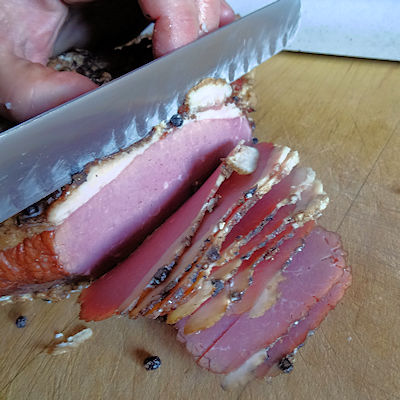
Ingredients
- whole packer brisket
- water to cover
- Brine- for each kg of meat and water:
- 30 ml kosher salt
- 3 grams prague powder #1
- 25 ml sugar
- 1 bay leaf
- 1 ½ ml garlic powder
- 1 ½ ml juniper berries
- 1 ½ ml black peppercorns
- Rub- for each kg of meat:
- 20 ml peppercorns
- 20 ml juniper berries
- 12 ml whole coriander
Instructions
- If desired, remove the point from the brisket for leaner pastrami.
- Weigh the meat and write the amount down.
- Use a non-reactive container for brining.
- Cover the meat in water and weigh the meat and water.
- Remove the meat from the water.
- Multiply the brine ingredients by the weight of the meat and water in kg.
- Add the brine ingredients to the water and stir to dissolve.
- Inject the brisket every inch or so with brine.
- Put the brisket in the brine and put a plate on it to submerge it.
- Put in the fridge for 4 days, turning occasionally.
- Take the brisket out of the brine and inject it every inch or so with brine.
- Put the brisket back in the brine and refrigerate for 5 days, turning occasionally.
- Rinse the brisket under cold water.
- Multiply the rub ingredients by the weight of the meat in kg.
- Run the ingredients through a spice grinder for only a quick pulse to just break some of the seeds. Do not grind fine.
- Rub the rub onto all surfaces of the brisket.
- Wrap the brisket in plastic wrap and put in the fridge for 2 days.
- Unwrap the brisket and let dry on the counter for 2 hours patting with paper towel every 15 minutes or put in a 140-150 F oven for one hour.
- Smoke at 230 F to an internal temperature of 150 F.
- Steam over, not in, water at a low boil for 3 hours.
- Can be served hot or sliced cold and reheated for future use.



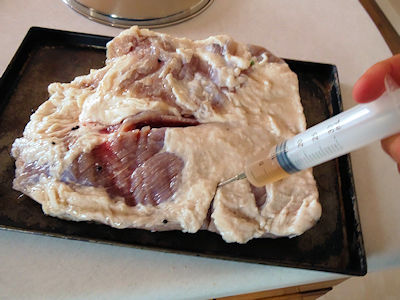

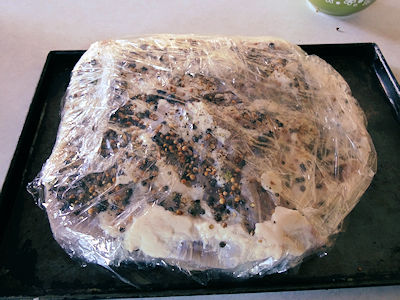


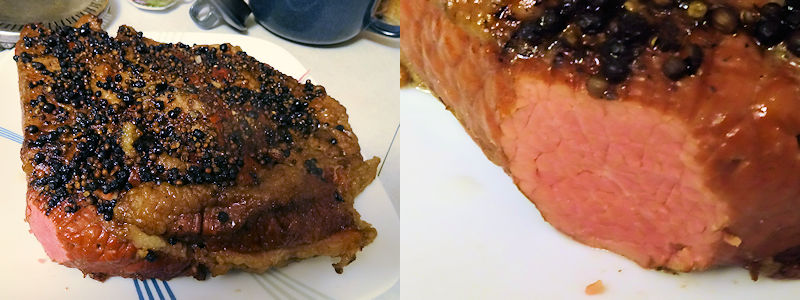


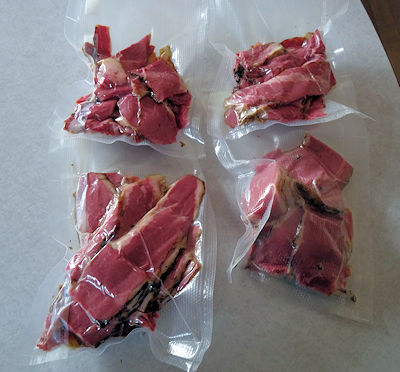
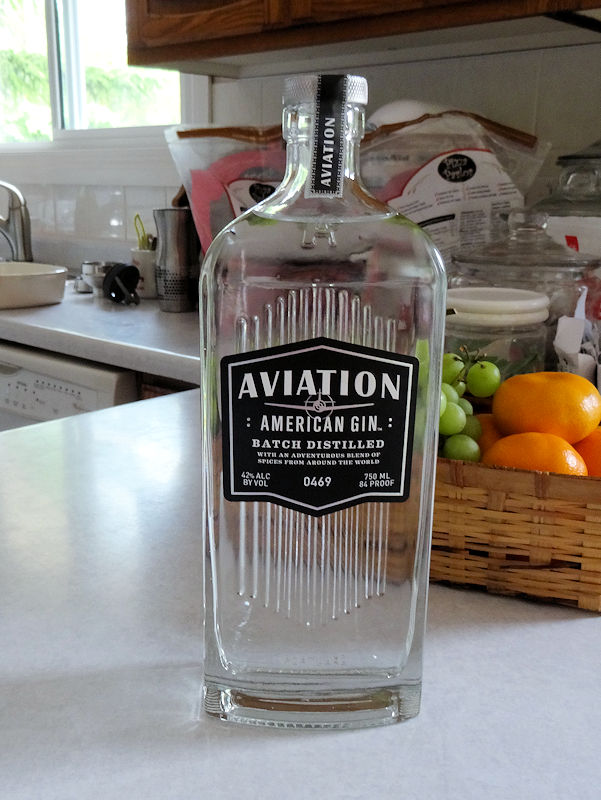


11 Responses
I wish I lived close to you. I would come over for dinner every week. You always have the best looking meats! I love pastrami and this looks delicious!!!
You are too kind. If you are ever in the Canadian Rockies, I will cook for you!
I love a good pastrami, it is something I don’t have nearly often enough! Yours looks amazing, of course!
Isn’t bad for your health to not get enough pastrami? Thanks for the compliment!
Hey my friend! I’m posting my hot pastrami sandwich recipe today in honor of January 14th Hot Pastrami Day. So… I’m including a link to your amazing recipe here at Old Fat Guy, in case anyone wants to make their own from scratch.
I also have to echo what Dawn said: “I wish I lived close to you. I would come over for dinner every week.” !!
You are way too kind! Thank you!
*Big Smile* … you’re very welcome!
Thank you for the tremendous effort you made to create this page of instructions. I will follow the pastrami seasoning part for my first attempt.
I hope it works well for you! I love home made pastrami!
I am new to the smoking world and through your book and encouraging guidance I just completed this recipe.
I would like to say to anyone that reads this,”you have to make this recipe”.
Thanks for all your help and encouragement.
Thanks so much, Norm! I love pastrami, too!